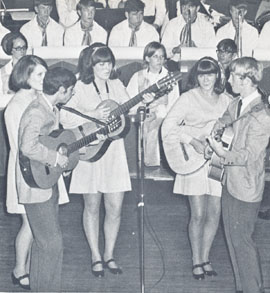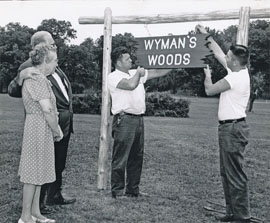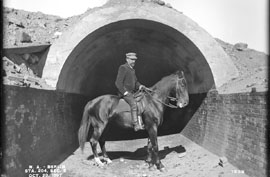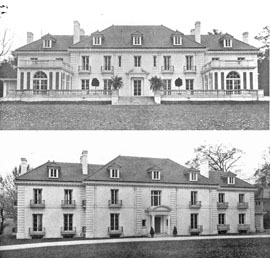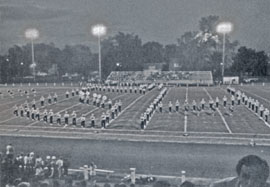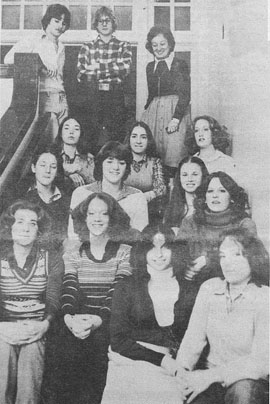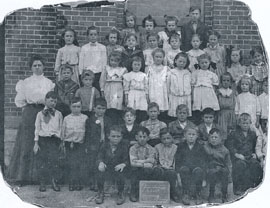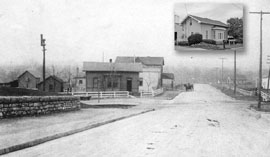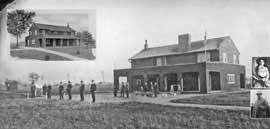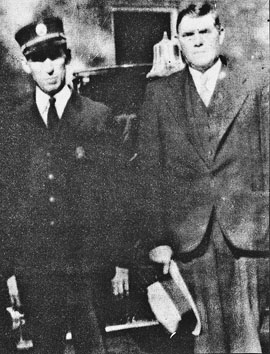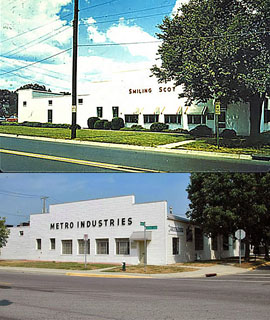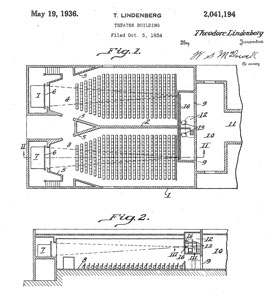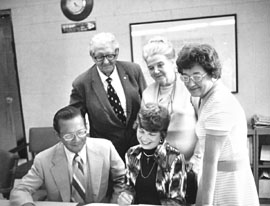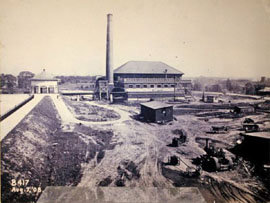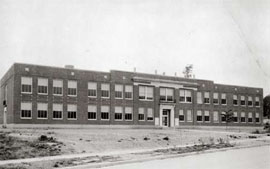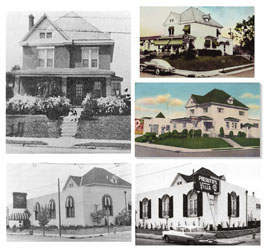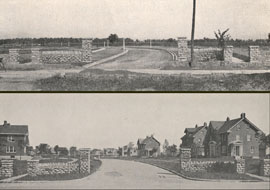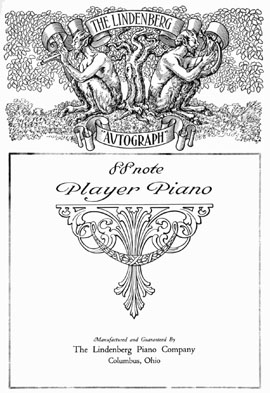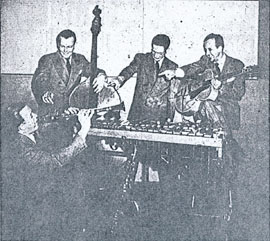Oswald Hering (1874-1941) was a noted New York architect and author. The son of a civil engineer, Hering studied architecture at MIT and Beaux Arts in Paris. In 1901, he opened his own architectural practice in New York City. Hering specialized in country and suburban homes and pioneered the residential use of reinforced concrete. He designed several noted homes, including the Sheldon Mansion in Marble Cliff (featured in last week’s Moment in Time.) Hering was the author of many books, including Concrete and Stucco Houses (1912) and Economy in Home Building (1924). One of his published philosophies was that the architectural design benefitted from a strong friendship with the client, that allowed the architect to realize the owner’s vision. The Sheldon Mansion was used in many publications as an example of this philosophy. As Mr. Hering himself said in one such article, "Mr. Sheldon’s residence is a good example of the success attained when the client is willing to 'make friends' with his architect. This implies a more or less intimate relationship, calling for an exchange of confidences, and the development of mutual trust and respect." Hering is shown at the left of this photo. On the right are interior photos of the Sheldon Mansion, including the stairway entry at the top, and the den at the bottom.
Band members worked hard in 1983. They raked leaves, painted house numbers on curbs, sold candy, nuts, and band calendars, all to raise money for new band uniforms -118 of them. Here they are pictured on the field in their new proudly earned uniforms during one of their ten performances of the year. Band director Cherie Tolliver, the director of one of the largest Grandview Heights High School marching bands, had the musicians well dressed and performing in parades, at the Ox Roast, leading the costume parade at the Halloween street dance and giving the traditional marching band concert in November. The band's spectacular performances boasted songs by the Doobie Brothers (Long Train Running) and Styx (Lady) that had the crowds in the stadium cheering with pleasure.
Former Marble Cliff resident Bradley Skeeles indicated in his memoirs that prior to WWI cars were a luxury in Grandview and their use was limited to recreational driving, partly because most of the roads were unpaved, full of ruts, and impassable seas of mud when wet. Car purchases were big news in the day. The April 15, 1906 Columbus Dispatch reported that Mable Cliff resident Carl Hoster purchased a $9,000 Fiat and a 35 horsepower Pope-Toledo. Other residents Samuel Prescott Bush, Eugene Gray, and Theodore Lindenberg followed suit and also purchased Pope-Toledos. George Urlin, however, bought a Frayer-Miller with a limousine body. Frayer-Millers were manufactured in Columbus. This composite shows ads for the Pope-Toledo (left) and the Frayer-Miller Limousine body (right) from 1906. A story that circulated was that when the Frayer-Miller company was established in Columbus, a teenage boy stopped and insisted that they allow him to work in their shop. The boy was Eddie Rickenbacker. In today's dollars, Carl Hoster's Fiat would cost over $210,000.
Pictured in this 1979 photo are fourteen second, third, and fourth year French students at Grandview Heights High School. They were selected as part of an exchange program sponsored in this country by the National Association of Secondary School Principals and in France, by the French Ministry of Education. The trip covered a total of 23 days, four of which were spent sightseeing. The students then returned to the Parisian suburb of Maison-Alfort and attended classes at Lycee Eugene Delacroix. Being able to afford the trip was never a requirement of the program - conversational French was. Students with the best ability to use the language were selected, and funds were raised by student projects and private donations to the School Exchange Services Committee. Ten Delacroix students came to spend time in Grandview classrooms, and the GHHS students went abroad. The exchange was planned and managed by Garda Hofmann, GHHS French teacher, and Principal John Hanlon. Pictured left to right from the bottom are Leah Lacoco, Tracy Knippenburg, Debbie Dericho, Miriam Tucker; second row: Anne Flinn, Molly Wilcox, Heidi Williams, Laura Radcliffe; third row: Carmel Rooney, Theresa Reilly, Rena Shere; top row: Kirk Hickman, Lonnie Owen and teacher Garda Hofmann.
This photo, taken around 1908, shows Ralph Karns (third from the left, front row) with Laura Walcott Karns (third student from the left, third row) with their elementary class and teacher Miss Andrus. Laura was the daughter C.H. Walcutt and Janette Howard, early residents of the Grandview area. The Walcutts moved into their home on Goodale Boulevard and Elmwood Avenue in March of 1902 when Laura was seven months old. She had five siblings: Ethel, who died at the age of five months, Lester, Edna, Oscar and Harry. From the vantage point on the hill overlooking Goodale, Laura remembers the 1913 flood, noisy trains, streetcars, and attending school in a four room brick building on Fairview Avenue, which according to her was often a sea of mud. Ralph and Laura visited their sister-in-law in Grandview in 1975, and were interviewed for an article in the Tri-Village News. They shared memories of the "little red school house", coasting down Stone's hill, elaborate floats in the Field Day celebrations, and going to Charlie Chaplin movies. Laura graduated from Grandview High School in 1919, and she and Ralph were married in 1922.
This 1895 photo depicts a view looking west along Fifth Avenue toward Dublin Pike (now Dublin Road). It shows the Scioto Depot (later called the Marble Cliff Station) of the Pennsylvania Railroad on the left side of Fifth, with the railroad tracks running left to right beyond the stone wall, which is part of the J.E. Price estate. Price was one of the founders of Arlington, which was renamed Marble Cliff. The intersecting road, barely seen at the extreme lower right of the photo, now serves First Community Village in Upper Arlington. A treeline along the Scioto River is visible through the haze in the background. In the 1930s, the depot building was moved across the Scioto River to 2057 Old Dublin Road, just north of Trabue, to become the office of the Marble Cliff Oil Company (inset photo, attributed to Galen Gonser). The Pennsylvania railroad (built in this area in 1868 as the Columbus, Chicago, Indianapolis Central Railroad) had a "flag stop" depot on Grandview Avenue, where the NAPA store is currently located, and later the busy Marble Cliff station (currently the site of NiSource).
This beautiful home on Fifth Avenue at Roxbury in Marble Cliff has been an office building for the past several decades. It was originally built by William K. Lanman, president of the Columbus Bolt Company and his wife Harriet Sharp Lanman. Mr Lanman, who died in 1938 had 3 sons and a daughter, including Colonel W.K. Lanman who was executive officer of the legendary World War II "Flying Boxcar" SCAT squadron, and Dr. Jonathan T. Lanman who was a famous collector of oriental maps. Both sons donated extensively to Yale University. The home was owned for a short time by E.W. Ingram, when he relocated the headquarters of White Castle to Columbus.
A group of sportsmen prepare for a round of trap shooting, while another group awaits a turn, at the Columbus (Arlington) Gun Club. This structure was designed in 1905 by J Upton Gribben, a noted Columbus architect and former protege of Frank Packard. It served as the center of social activity for prominent citizens of the area, as skeet shooting was a national passion during this time.The Gun Club was located on the north side of Fifth Avenue between Arlington Avenue and Cambridge Blvd. until the Northwest Boulevard Company began the development of the Country Club District in 1915, which was the first development in what would become Upper Arlington. At that time the Club moved to a new building on the north side of King Avenue at Andover. The Club was the site of the Grand American Handicap Trap Shoot in 1908, and attracted famous shooters like Annie Oakley (top inset) and John Philip Sousa (bottom inset). It is reported in the book History of Upper Arlington that an all wood motordrome, for use in racing motorcycles, was located on the Gun Club property. The building (front view in upper left inset) was used as the field office for the Northwest Boulevard Company after the club moved, and the Armstrong family, some of the earliest UA residents, lived in the second floor rooms.
In 1924 the newly organized Grandview Heights Fire Department had become Franklin County's second (after Columbus) fire department to purchase a motorized fire fighting apparatus. It was August 8 when the newly acquired Seagrave Engine No.1 pumped its first water at a fire scene, a grass fire near Goodale and Northwest Boulevard Avenues. Simultaneous organization of the fire department required hiring the first fire chief and the first full time professional firefighter. The village had been formerly served by a fully volunteer brigade. Salaries were set at $115 a month, with the top of the salary schedule set to be $140 a month. The chief and his family were provided free living quarters over the newly completed fire house-city hall complex on Grandview Avenue. Firemen later lived in the basement when on duty. The new Engine No.1, a Seagrave Suburbanite, was retired from active fire service in 1953. Grandview's first fire chief, Merle Klingensmith, Sr. is pictured here on the right with Lt. R. McAllister.
Before and After: The Smiling Scot Wholesale Showroom (top photo, from a 1962 publicity postcard), managed by Don Gump and his wife Dotty, was located at the corner of Goodale Blvd. and Palmer Road in Grandview. The building, on land originally part of the Northwest Blvd. Company subdivision, was owned by Ohio Laboratories, Inc, suppliers of home cleaning products and general housewares. Smiling Scot was originally trademarked in 1936, and the Gumps established it as a wholesale outlet. It it became a popular place to purchase items that were out of the ordinary and local residents frequented the showroom for unique collectibles and gifts. A classified ad in the January 1959 Popular Mechanics magazine solicited sales agents for the company. The ad stated: “AGENTS WANTED: FABULOUS Money Makers. Fast selling dish cloths. 500 other popular articles. Lowest wholesale prices. Smiling Scot DP3 1266 Goodale, Columbus 8, Ohio.” The building is still standing and is now occupied by Metro Industries. Incorporated in 1966, Metro Industries is a family owned fastener and industrial distributor.
Theodore Lindenberg was born in Columbus Ohio in 1873, graduated from Cornell, and was associated (in various executive capacities) with the M.C. Lilley Company of Columbus, founded by his family shortly after the Civil War. In 1928 he assumed the presidency of this international supplier of fraternal memorabilia, but his real passion was related to revolutionizing the traditional movie theatre. He operated the Grandview Theatre and opened the Bexley Theatre in 1935. Lindenberg filed a patent in October 1934 for a movie theatre with "a plurality of auditoriums of relatively small size" with a shared lobby, that used a "single projector with a complicated mirror system" to project into both auditoriums (two drawings from the patent are shown here). Lindenberg used his patent as the model for the Bexley, with two auditoriums of approximately 250 seats each, and small screens (approximately 8'x10'). The Theater also incorporated a unique sound system, designed by Lindeberg and tested for a year at the Grandview Theater. The 1935 film "Naughty Marietta", starring Jeanette MacDonald, was the opening film, chosen because it exploited the sound system (the movie won an academy award for best sound mixing that year). Lindeberg lived in Grandview in the Frank Packard designed "Hacienda", his family home at 1070 Lincoln Road.
William J. Merkle was the son of wealthy Columbus businessman Peter Merkle, who in the late 1800s owned the business Peter Merkle & Sons. This company operated many restaurants and shops in railroad terminals throughout the midwest, including one in Columbus’ Union Station. William Merkle’s wife was Ada Boyle of Cincinnati, who was one of six children and the only daughter of James Boyle, who served as the private secretary to Ohio Governor and U.S. President William McKinley. Mr. Boyle was also a partner in the firm Boyle and Roach in Cincinnati. This firm was responsible for a significant number of public works projects, including the Locks at Sault St. Marie in Michigan, and a portion of the Little Miami Railroad. After marrying in 1895, Ada Boyle and William Merkle settled in Columbus, and in 1910 purchased the Sylvio Casparis home in Marble Cliff, which later became the convent for Our Lady of Victory Church. There they raised their three daughters and three sons and resided until 1922. The "petite beauty" Ada Boyle (as she was described in the March 21, 1895 social section of the Cincinnate Enquirer) is shown in this undated photograph, which has been estimated to be near the time of her marriage to Merkle.
The steam railroad came to Columbus around 1850 and played an important role as the area that is now Grandview Heights and Marble Cliff was opened to settlement. In this photograph, a locomotive of the Pennsylvania Railroad crosses the Scioto River at the western edge of Marble Cliff. The railroad line passing through Marble Cliff (with a flag stop at Grandview Avenue and a depot at Fifth Avenue and Dublin Pike) was initially established in 1849 as the Columbus Piqua & Indiana Railroad, with the goal of providing the link between Columbus and Indianapolis. The first leg, between Columbus, through Marble Cliff, to Plain City was operational in 1853, with extensions to Urbana and Piqua the next year. The line evolved through several reorganizations and mergers over the next decades to be an important link to Chicago as well. After the CP&I company was foreclosed in 1863, it was reborn (after several short periods) from 1868 until 1883 as the Columbus, Chicago and Indiana Central Railroad. It then became the Pittsburgh Cincinnati Chicago & St. Louis Railroad, and the Pennsylvania Railroad assumed the oversight of the line in 1921.
This aerial photo, taken in 1949, shows Grandview Avenue just to the south of Dublin Road, at approximately the location of the I-670 interchange. The light area in the bottom half of the image is the eastern edge of the American Aggregates stone quarry, which stretched from this location north and west to Trabue Road and San Margherita. The area inside the circle shows a locomotive that pulled cars loaded with stone from the quarry, through a tunnel (in the center of the circle) that went under Grandview Avenue, curved north, went under Dublin Road, and finally connected with the railroad tracks at the Pennsylvania Railroad’s Grandview Yard, which was located just to the north of the Coca-Cola plant on Twin Rivers Drive just south of Goodale Blvd.
The Grandview Heights/Marble Cliff Historical Society lost a special friend last week, with the passing of Win Keller, one of the founders of the Society. This 1974 photo shows the founding officers, including new President Keller, seated at the right, next to Vice President Dirk Voelker. Standing are Grandview Mayor Joseph Wyman, treasurer Virginia Abbot, and Councilwoman Ann Larrick, secretary. Win has tirelessly given her time and attention to the Historical Society, and to other local organizations such as the Grandview Civic Welfare Club. As her obituary read, “She loved her community and found enrichment, fellowship and pleasure in giving of herself to her neighbor.” Needless to say, her community loved her as well, and she will be greatly missed.
This photo shows the construction of the Scioto River Pumping Station, built in 1908 by the Columbus Water Works on the site of the current Dublin Road Water Treatment Plant just east of the Grandview Heights city boundary. This facility replaced the original pumping station, which was built in 1871 to provide water for the expanding Columbus city, and to replace the thousands of wells that had served residents. This station included the first water filtration system in the United States, and was designed as part of what was called the Great Columbus Experiment of 1908. In 1904 a prominent politician, Senator Marcus Hanna, died of typhoid, which he allegedly contracted after drinking tainted Columbus water. As a result of his death, a group of scientists and sanitary engineering trained individuals were mobilized to study the problem, resulting in the 1908 effort, and the water filtration system was invented and installed in this new facility.
In 1924, a levy was placed on the ballot in Grandview to build a new elementary school to accommodate the growing number of children in homes on the east side of the city. The proposed $175,000 levy was defeated in the November elections, and the district was forced to go to half-day sessions in grades one to three. The issue was again placed on the ballot in November of 1925, and it passed. It provided $140,000 for construction of the new school and funds that were used to purchase the property that would be used to build the high school stadium. This photo shows the building near the end of the construction in 1926. The project was done by the Elford Company, overseen by Harold “Fat” Elford, who had previously served as the mayor of Upper Arlington. The delay caused by the failure of the levy in 1924 actually proved beneficial. The number of rooms was increased from the eight specified in the original plan to twelve because of additional need, but the cost for a building went down by $8000 because of timing of the bids. The design was also modified to allow for expansion of an additional four rooms on each end of the building.
This sequence of images shows the many faces of Presutti’s Restaurant over the years, as it was expanded to accommodate more customers and services. Moving clockwise from the upper left, the original Salvatore Presutti home at 1692 West Fifth Avenue (which the family occupied in 1920) is shown. In order to afford their original restaurant, the TAT in Flytown, Presutti tried to sell the house in the early 1930s. When he couldn’t because of the economy, he decided to sell the restaurant and open the TAT Villa in his home in 1933 (upper right). An addition was added to the front, with a new entry and expanded kitchen, and it was renamed Presutti’s Villa in 1939 (middle right). Another addition added dining rooms and a bake shop (lower right). After a fire in the kitchen of the restaurant, Presutti's Villa closed in 1981. It opened for a brief time as JoAnn's Chili Bordello, and as a Thai barbeque style eatery called the Tartar, and finally as Presutti’s Amici Restaurant before the building was razed. The Sherwin-Williams paint store is currently on the property.
The Upper Arlington Company, owned by brothers King and Ben Thompson, set out to develop a planned community just to the north of what was then Arlington (now Marble Cliff) on the Miller farmland in 1915. The formal entrance to the new community was at the corner of Fifth Avenue and Cambridge Blvd. The top photo in this composite shows the entry, with the stone fence and columns, the newly constructed road and curbs, and light posts and sidewalks. The bottom photo, taken three years later in 1918, shows the same entry with newly constructed homes on both sides of Cambridge. Development was interrupted in 1916 when National Guard troops, preparing to participate in the protection of the U.S./ Mexico border, used the site as a training camp, known as Camp Willis. UA was incorporated in March of 1918.
Grandview Heights resident Paul Lindenberg was the son of Charles Lindenberg, whose Broad Street home later became the Ohio Governor’s mansion. Paul Lindenberg was a 1903 graduate of Yale University, and assumed the presidency of his father’s piano manufacturing business, the Columbus Piano Company shortly after graduation. It was renamed the Lindenberg Piano Company in 1915, and specialized in mail-order player pianos. Lindenberg employed two of his Yale classmates as officers of his company, Kenneth Curtis as sales manager and Ernest Bacon as factory superintendent. The firm built higher quality pianos and player pianos under the names of Lindenberg, Columbus, Wondertone, Convertola, Columbia, and Boudoir at their plant at the corner of Buttles and Michigan Avenue in Victorian Village. A fire damaged the plant in 1918, and they relocated to Gift and Culbertson in the Hilltop. This photo shows the cover of a piano manual for one of his designed-for-the-home upright pianos, which sold for approximately $250 and was shipped directly to the purchaser at no charge.
In 1946, the four ex-servicemen pictured here became known as The Dick Hein Quartet. They were hired as part of the WBNS Orchestra in April, 1946 and quickly became popular among music lovers throughout Ohio. It was in 1947 that their favorite restaurant, Presutti's Villa, proudly advertised that the quartet would be playing nightly, Tuesday through Saturday, in the "beautiful Crystalier room" of the restaurant. Presutti's menu was known from coast to coast for appetite appeal. The choicest of steaks, chops, fowl and sea foods beckoned the diner. Also known for their famous home made spaghetti and ravioli, the restaurant owners, Mr. and Mrs. S. Presutti, served their patrons in a large home located on West Fifth Avenue. The addition of music completed the pleasure of good food in beautiful surroundings. Later performers included WLWC-TV (WCMH) personality and organist Charlie Cesner, and WBNS pianist Walter Knick.
